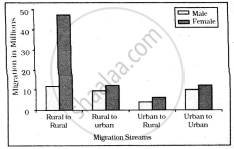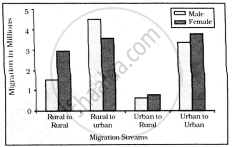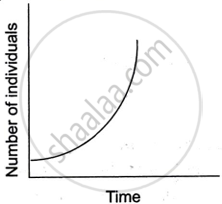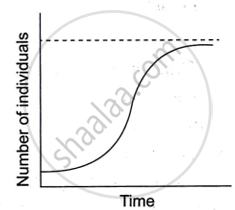Advertisements
Advertisements
प्रश्न
Examine the different aspects of the growth of population in India during 1951-1981 and 1981-2021.
उत्तर
- The decades 1951-1981 are referred to as the period of population explosion in India, which was caused by a rapid fall in the mortality rate but a high fertility rate of population in the country.
- The average annual growth rate was as high as 2.2 per cent. It is in this period, after the Independence, that developmental activities were introduced through a centralised planning process and economy started showing up ensuring the improvement of living condition of people at large.
- Consequently, there was a high natural increase and higher growth rate. Besides, increased international migration bringing in Tibetans, Bangladeshis, Nepalies and even people from Pakistan contributed to the high growth rate.
- In the post 1981 till present, the growth rate of country’s population though remained high, has started slowing down gradually.
- The growth rate of population is, however, still high in the country, and it has been projected by World Development Report that population of India will touch 1,350 million by 2025.
APPEARS IN
संबंधित प्रश्न
List any three important characteristics of a population and explain.
If the birth rate is greater than the death rate then the population ______.
Examine the following statement and correct the incorrect one.
There is an adverse impact on manpower in the regions of out-migration.
Examine the following statement and correct the incorrect one.
Greater economic prosperity indicates the development of a region.
Examine the following statement and correct the incorrect one.
Developing countries have an HDI of 1.
Identify the correct correlation :
A: Assertion; R: Reasoning
A: Population of a region does not change.
R: Birth rate, death rate, and migration affect the population of a region.
Identify the correct correlation :
A: Assertion; R: Reasoning
A: In stage 2, the death rate reduces but the birth rate is constant.
R: The population increases rapidly in stage 2.
Write a short note on the correlation between birth rates and death rates.
Assertion: Population of a region does not change.
Reason: Birth rate, death rate and migration affect the population of a region.
Differentiate between
Crude Birth Rate and Crude Death Rate
India’s population as per 2011 census is:
Which one of the following is not a push factor?
How long did the world take to increase its population from 5 billion to 6 billion?
What is the impact of migration?
What is population growth? What does population change indicate for an area?
Why do people migrate in large numbers from rural to urban areas in India?
How many stages/phases of population growth?
The continent that has the lowest growth rate of population.
Population increased by the difference between births and deaths in a particular region between two points of time.
Which one of the following is not a component of population change?
How many times the world population has increased during the last 500 years?
Which of the following is not a push factor for migration?
The ten most populated countries have a ______ world population.
Which of these statements is not true?
Study the given graph carefully and answer the following question:

Intra-state Migration by place of Last Residence Indicating Migration Streams India, 2011

Inter-state Migration by Place of Last Residence Indicating Migration Streams India, 2011
Who dominates the inter-state migration of short distances?
On the basis of the demographic data of a country given below, construct an age pyramid and explain whether the population is stable, declining or growing.
| Age group | No. of individuals |
| Pre-reproductive | 20,000 |
| Reproductive | 15,000 |
| Post-reproductive | 10,000 |
Crude Death Rate (CDR):-
Which of these is a major cause of female migration in India?
Which of the following pairs is not correctly matched?
India's population is larger than the total population of which of the following?
If a population of 50 Paramoecium present in a pool increases to 150 after an hour, what would be the growth rate of population?
What would be the per cent growth or birth rate per individual per hour for the same population mentioned in the previous question (Question 10)?
In 2005, for each of the 14 million people present in a country, 0.028 were born and 0.008 died during the year. Using exponential equation, the number of people present in 2015 is predicted as ______.
A population of Paramoecium caudatum was grown in a culture medium. After 5 days the culture medium became overcrowed with Paramoeium and had depleted nutrients. What will happen to the population and what type of growth curve will the population attain? Draw the growth curve.
Which of the following may be interpreted as a spontaneous effort to achieve a better balance between population and resources?
"Migration may be interpreted as a spontaneous effort to achieve a better balance between population and resources." Examine the statement in context of pull and push factors that influence migration.
Analyse the main features of Phase-III (1951 - 81) of growth of population in India.
Consider the following and choose the correct answer with the help of given codes-
| STAGES OF POPULATION | GROWTH FEATURES |
| I Period between 1901 to 1921 | 1. Period of steady growth |
| II Period between 1921 to 1951 | 2. Phase of stagnant growth of Population |
| III Period between 1951 to 1981 | 3. High but decreasing growth rate |
| IV After 1981 till present | 4. Period of population explosion |
Assertion (A): Population of a region does not change.
Reasoning (R): Birth rate, death rate and migration affect the population of a region.
Which one of the following is the largest linguistic group of India?
Assertion (A): Population of a region does not change.
Reasoning (R): Birth rate, death rate and migration affect the population of a region.
Assertion: Population of a region does not change.
Reason: Birth rate, death rate and migration affect the population of a region.
Assertion: Population of a region does not change.
Reasoning: Birth rate, death rate and migration affect the population of a region.
Study the two figures shown below that represent two growth models.
 |
 |
| Figure A | Figure B |
- Which one of the two figures represents an unlimited supply of nutrients? Give a reason.
- Which figure depicts a challenge to population growth?
- Explain the term reproductive fitness.
- Give the mathematical expressions for Figure A and Figure B.
Define the following term:
Growth rate of population
Assertion (A): Population of a region does not change.
Reasoning (R): Birth rate, death rate and migration affect the population of a region.
